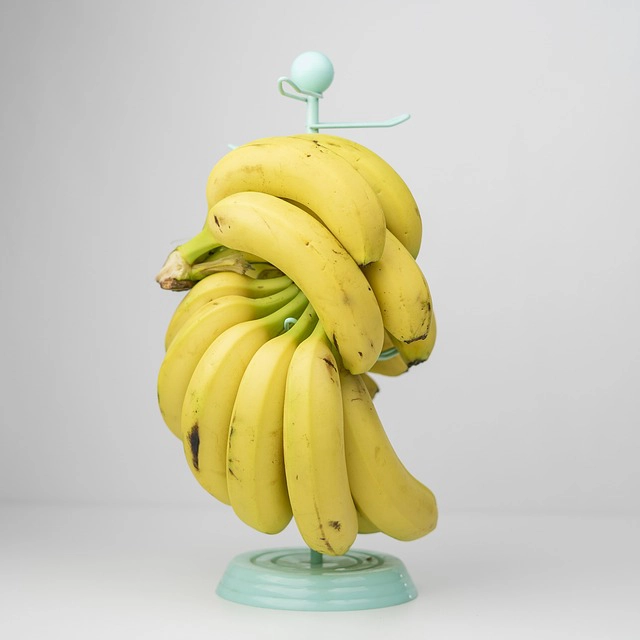The Birth of Food Photography
Food photography is primarily a type of still life photography where the subject is food.
Food photography was most likely influenced by and born from the tradition of still life paintings. Back in the early 17th century, especially in the Netherlands, painters made food the focal point of their artworks, capturing the beauty and abundance of daily life. These compositions typically included an array of foods like fruits, vegetables, and meats. This genre not only reflected the era's prosperity but also an interest in the fleeting nature of existence, symbolized by the perishable nature of the items portrayed.
It became logical that at the beginning of the invention of the medium, photographers also used still-life subjects such as food for their experiments. Taking pictures of objects that didn't move was crucial because it took a long time to capture the image.
Controlling how the picture looked and the lighting also made still life photography a good way to try out different ideas. Louis Jacques-Mandé Daguerre and Henry Fox Talbot, both took pictures of still objects in the late 1830s.
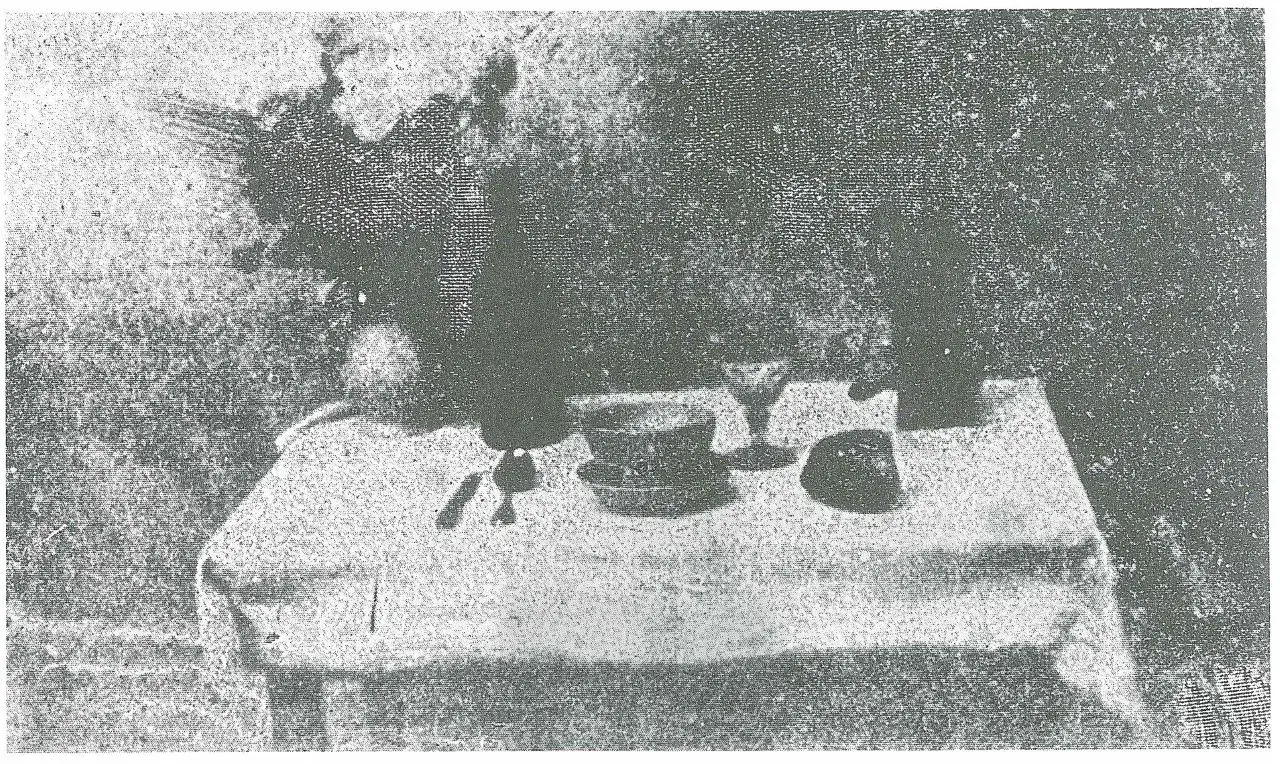
La Table Servie © Nicéphore Niépce
The first known photograph featuring some food is La table servie by Nicéphore Niépce. Since the shot was lost, some estimate it dates back to 1823/25, while others estimate 1832/33, when he worked with Daguerre using the Physautotype process they discovered in 1832.
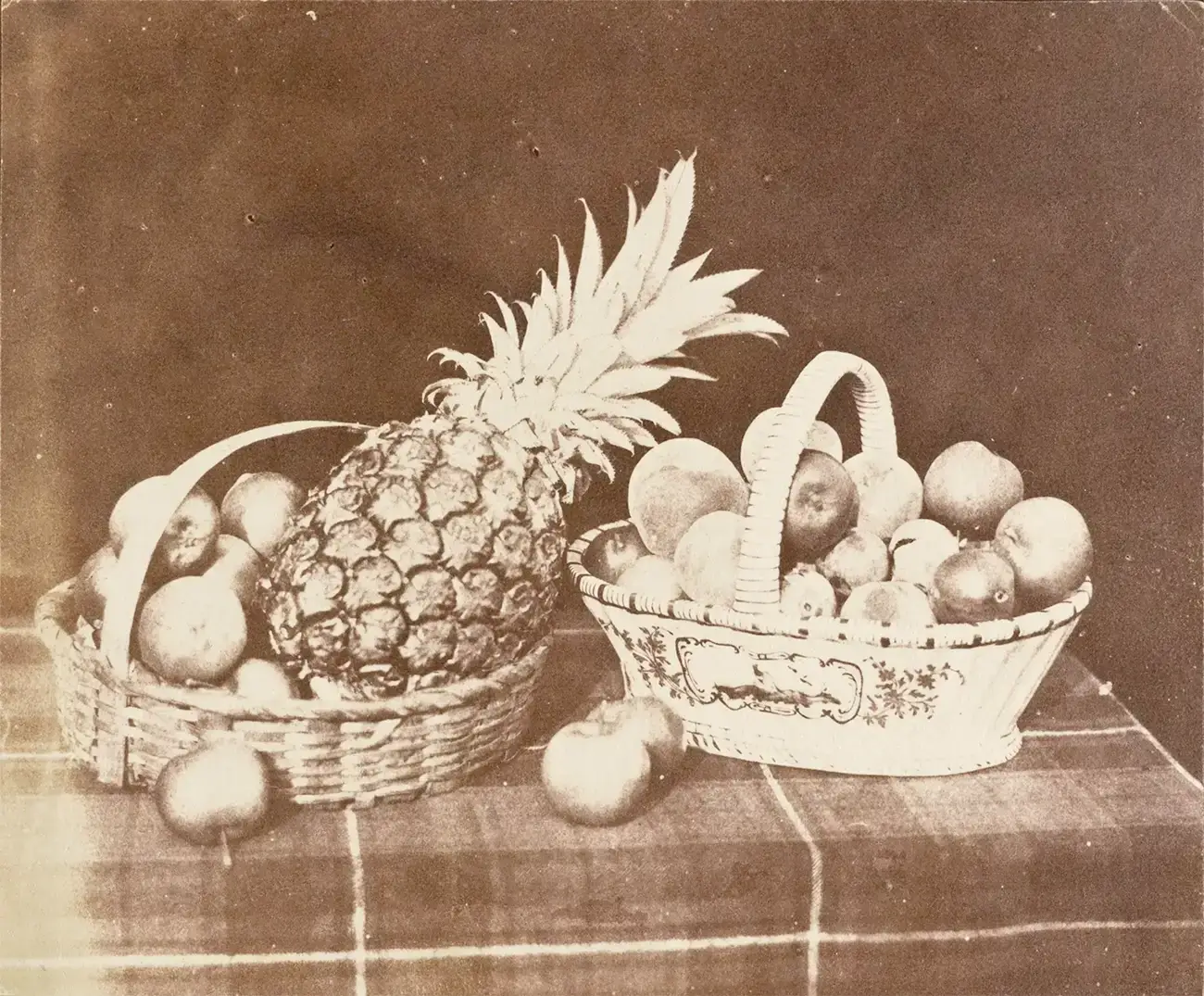
A Fruit Piece, 1845 © Henry Fox Talbot
However, some of the most famous images are from Henry Fox Talbot’s ‘The Pencil of Nature’ in 1844-46, a published book illustrated with photographs, showcasing fruit baskets arranged on patterned tablecloths. These compositions echo the style of 17th-century Flemish still-life paintings. Talbot's contributions in 'The Pencil of Nature' showcased the burgeoning capabilities of photography in both visual representation and artistic expression.
In the early 1900s, innovators like
Paul Strand started to break away from traditional still life norms. Inspired by Modernist painters like Paul Cézanne, Henri Matisse, and Pablo Picasso, Strand explored new visual approaches.
Around 1927,
Edward Steichen made further strides in reshaping food photography. Working for the Stehli Silk Corporation, he created a pattern for their American scarf series using
sugar cubes arranged meticulously and lit from behind to cast distinct shadows. This approach emphasized shape, form, and shadow over natural representation.
Food photography evolved into a unique art form, separate from traditional still life photography. It demonstrated that capturing food images could be an artistic endeavor, showcasing intricate and unexpected shapes.
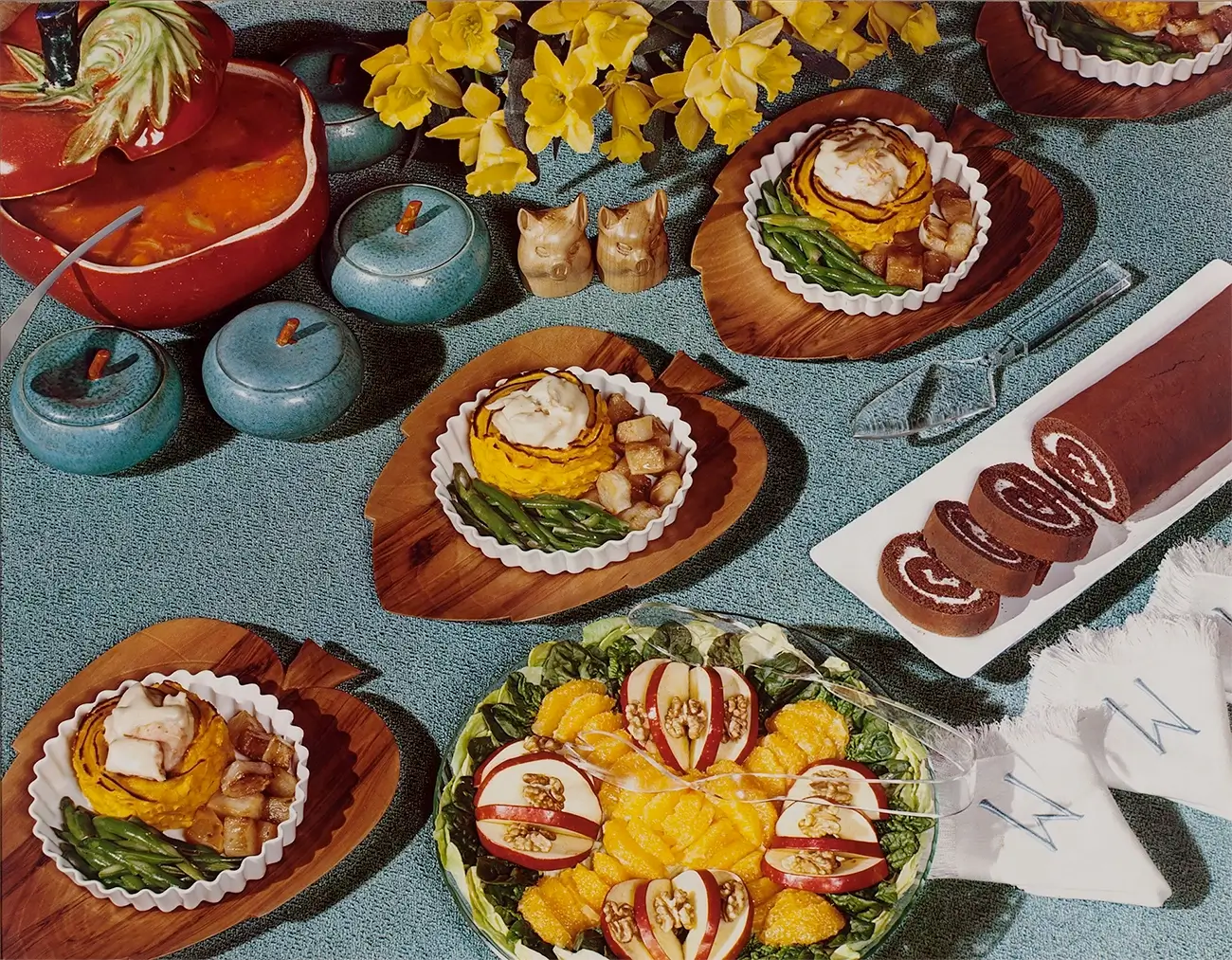
Food Spread, Daffodils, McCall’s magazine, ca. 1946 © Nickolas Muray Photo Archives, Courtesy George Eastman Museum, gift of Mrs. Nickolas Muray
By the mid-1930s, the introduction of color advertising marked a significant shift in food photography. It evolved from being solely a fine art to a tool for selling. Cookbooks of the time featured vibrant technicolor photography across multiple pages, reflecting this change in style and purpose.
The first color photograph was taken in 1861, but it wasn't until the 1930s that color photos started appearing in cookbooks due to the challenges of color printing. In 1935, Nickolas Muray used the three-color carbro process to create some of the earliest color food photographs. McCall's magazine hired Muray to produce colorful photos for their cooking pages. He continued using this process to create vivid food images for the magazine and other advertisers through the 1950s. These rich, colorful pictures were designed to catch the reader's eye in commercial photography.
To create the pictures for these booklets, photographers used bright, direct lighting on the food, resulting in highly saturated and vivid images. This was a big change from traditional food photography, which relied on natural light and careful composition to make the images stand out.
As time passed, the portrayal of food began to carry political significance. During the early days of World War II, Russell Lee documented families consuming modest meals of biscuits and beans, highlighting the poverty and hardship of the era. In 1964, Carolee Schneemann's work Meat Joy marked the beginning of feminist challenges to traditional perceptions of women as solely kitchen-keepers. Food also made its way into fashion photography; Helmut Newton captured images of fashion models posing with raw steak and roasted chicken, blending culinary elements with high fashion.
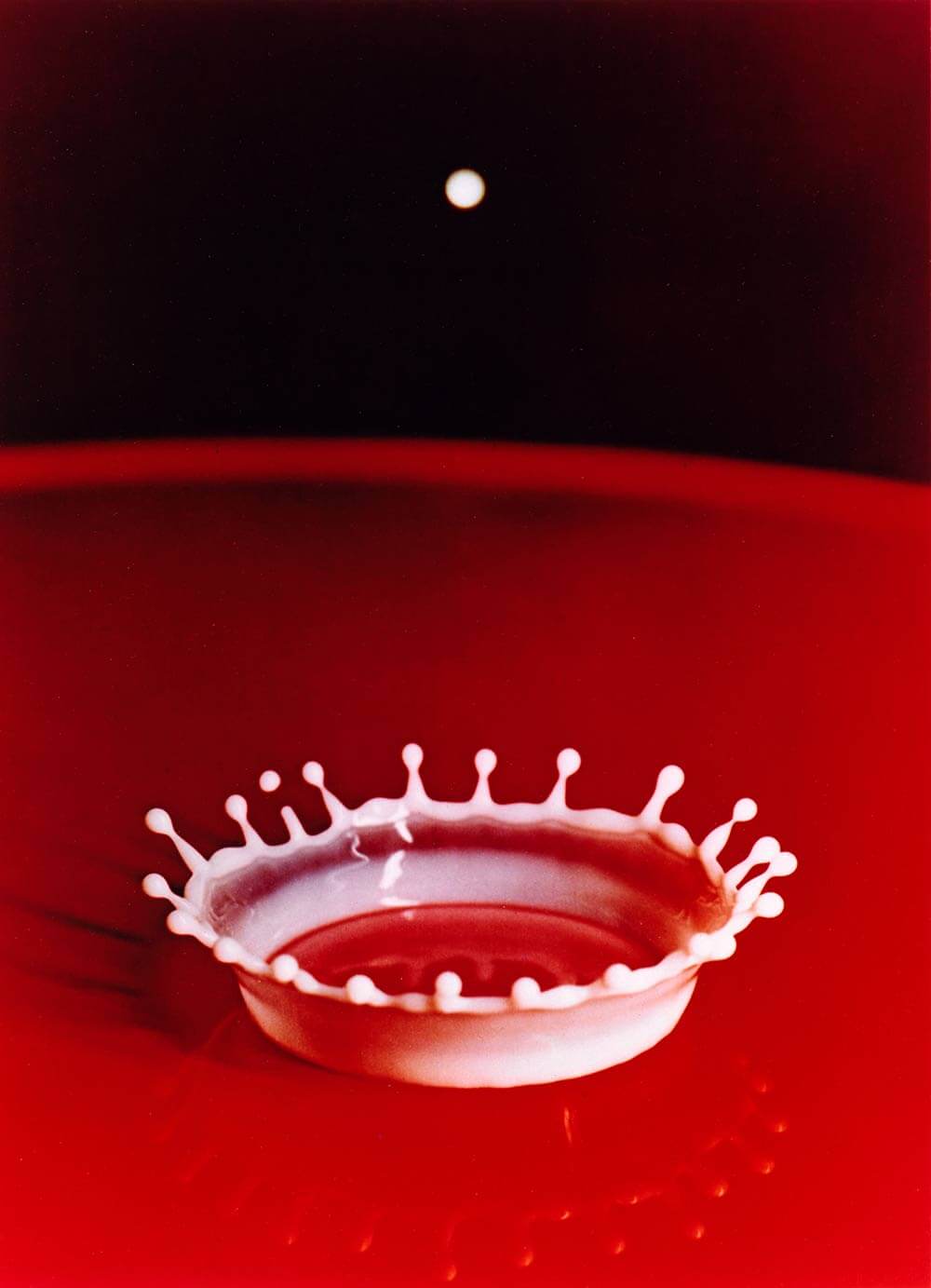
Harold Edgerton, Milk drop coronet, 1957, 50,8 x 40,64 cm épreuve dye-transfer Collection Arlette et Gus Kayafas © Harold Edgerton/MIT, courtesy Palm Press, Inc., from the Kayafas Collection
In the '50s and '60s, photographers experimented with food photography.
In 1957, Harold Edgerton, an MIT electrical engineering professor, used shutter motors and strobe lights to photograph a milk drop splash in an experiment called the Milk Drop Coronet. This technique froze the moment and revolutionized photography, leading to the invention of the electronic flash, which significantly impacted food and still life photography.
Food items are also being styled to give them a more attractive appearance, resulting in better photographs.
The 1970s introduced a quirky and often cheesy style of food photography. Everyday kitchen items were turned into art, even if they didn't look very appetizing.
In 1979, Peter Fischli and David Weiss created the Sausage Series (Wurstserie), where they arranged sausages and pickles like models. These photos highlighted their interest in ordinary objects and humor.
In the 1980s, food photography began to embrace a lifestyle approach. Lighting became more romantic, angles more experimental, and photographers started using a shallower depth of field as camera technology improved.
This period also saw the introduction of props and backdrops in food photography. Photographers started adding flowers, various backgrounds, and other food items to create a story around the dishes. They used darker backgrounds, creative garnishes, and lots of whipped cream. Retro food images from the 1980s were far from subtle.
Between the 1960s and 1990s, commercial photography in magazines, cookbooks, and ads had a dramatic flair. However, by the 1990s, there was a return to more natural images, making food appear edible again. During this time, photographers also started including people to enhance the storytelling, a trend that continues today with portrait shots of chefs and the inclusion of human elements in food photography.
Renowned photographers, celebrated for their fine art, continue to incorporate food into their images today. Food remains a captivating subject for artistic exploration, offering opportunities for symbolism, storytelling, and aesthetic experimentation. From still lifes to conceptual pieces, famous photographers use food as a versatile element to convey meaning, evoke emotion, and engage viewers in dialogue about culture, identity, and the human experience.
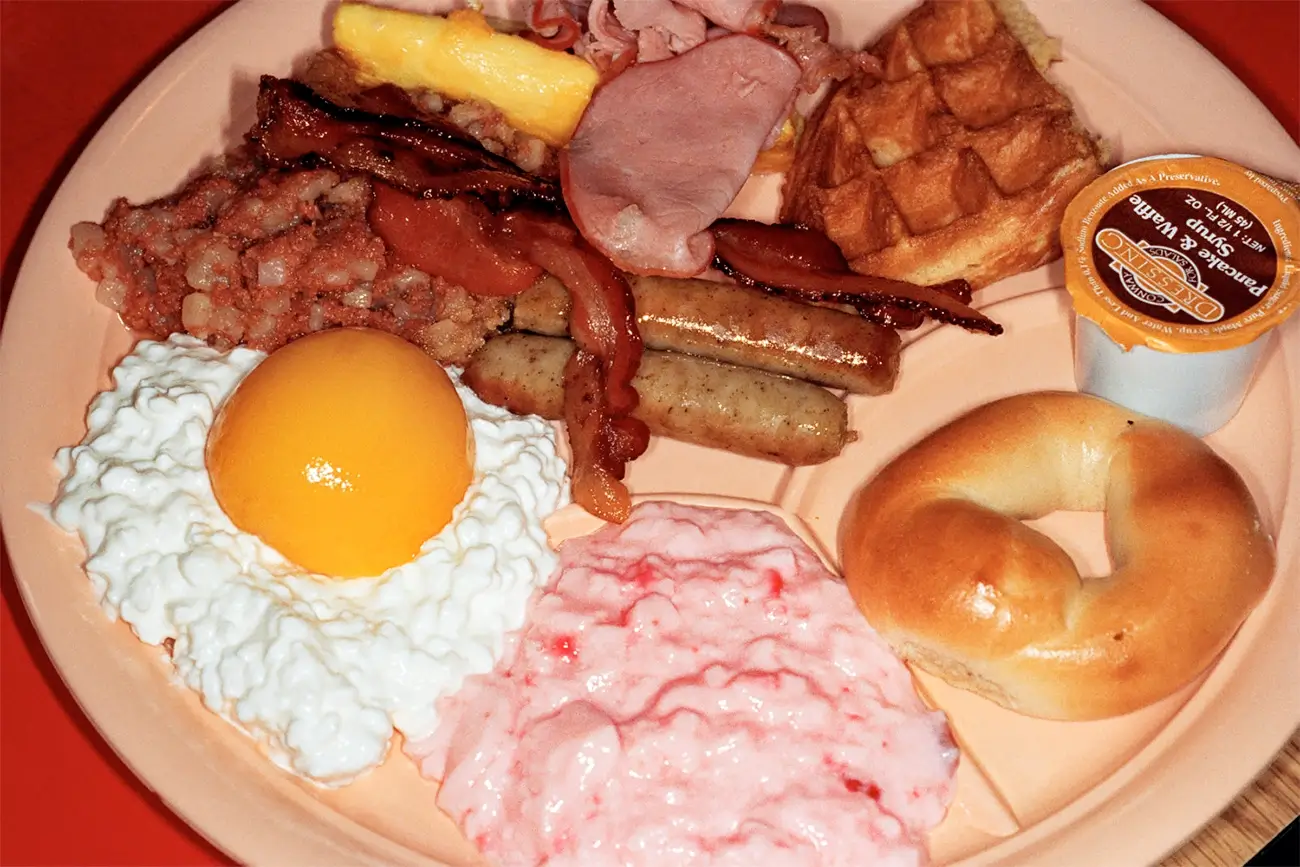
Real Food, Florida 1998 © Martin Parr / Magnum Photos
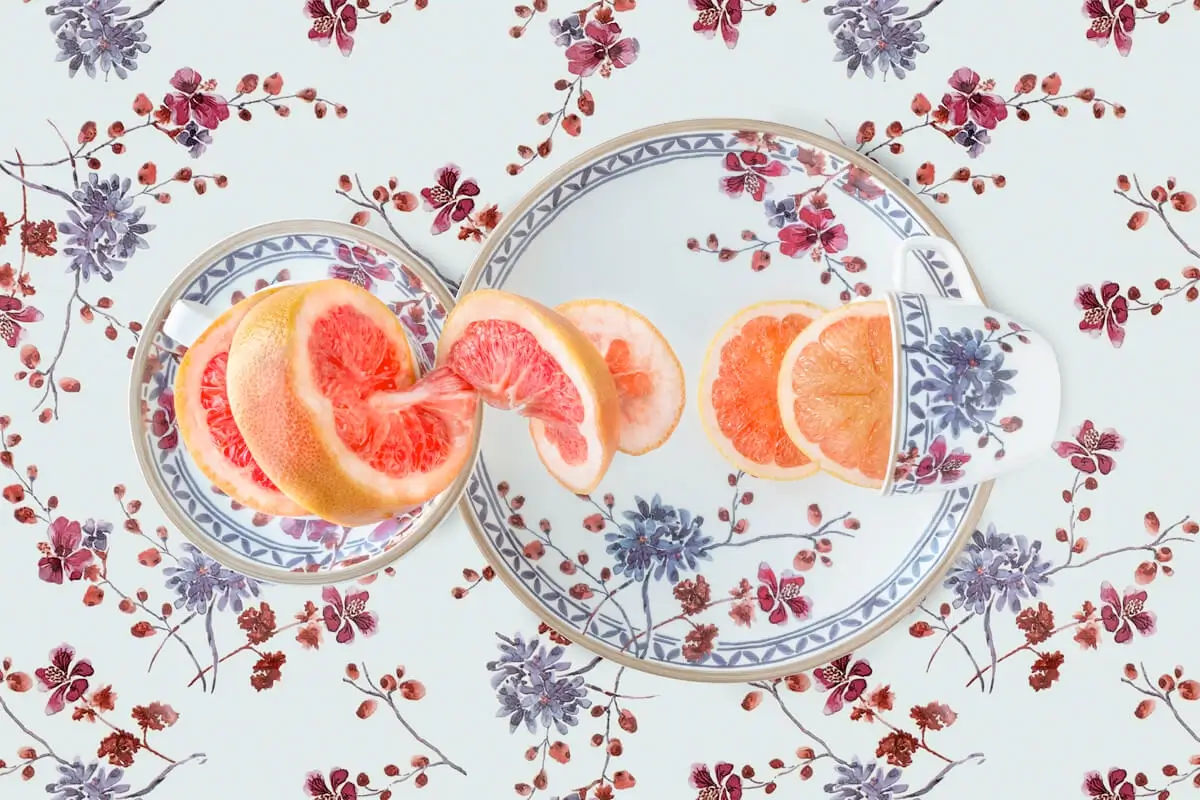
The Good Dishes © JP Terlizzi
Foodporn is now a growing trend. This trend involves people taking photos of their meals and sharing them on social media platforms. According to a 2016 study by the New York firm Ypulse, 63% of individuals aged between 13 and 30 post pictures of their food while they are eating.
The term Foodporn combines food with pornography, which typically involves representations intended to sexually arouse. Foodporn, therefore, involves visually enticing and stylized representations of food on social media, often evoking sensuality similar to sexy photographs. These images, abundant in excess, heighten the senses, triggering desire and appetite. Foodporn can be found in various platforms like advertisements, blogs, social media, and culinary shows, showcasing food in all its tempting glory.
Interestingly, the term Foodporn has roots predating the rise of social media. Alexander Cockburn introduced the term in December 1977 with his article in The New York Review of Books, where he described True gastro-porn as adding excitement through colorful photos of finished recipes. The term gained momentum when Michael F. Jacobson used it in a 1979 newsletter from the Center for Science in the Public Interest. Rosalind Coward, a feminist critic, in her 1984 book Female Desires, first used food pornography to describe how women's magazines present food with beautifully lit and retouched photos.
This culinary phenomenon stems from the art of creating visually stunning dishes and capturing them in photos, evoking a mixture of pleasure and guilt. It's akin to the forbidden pleasure associated with traditional pornography, triggering desire but also guilt. Journalist Frederick Kaufman highlighted how the food industry adopted techniques from erotic films in advertisements, sparking interest from food marketing specialists and advertisers.
Initially used to describe the visual appeal of food, the term evolved beyond its original meaning. In the United States, it became a critique of marketing practices, particularly those promoting high-fat treats. The hashtag #foodporn first appeared on Twitter around 2007.
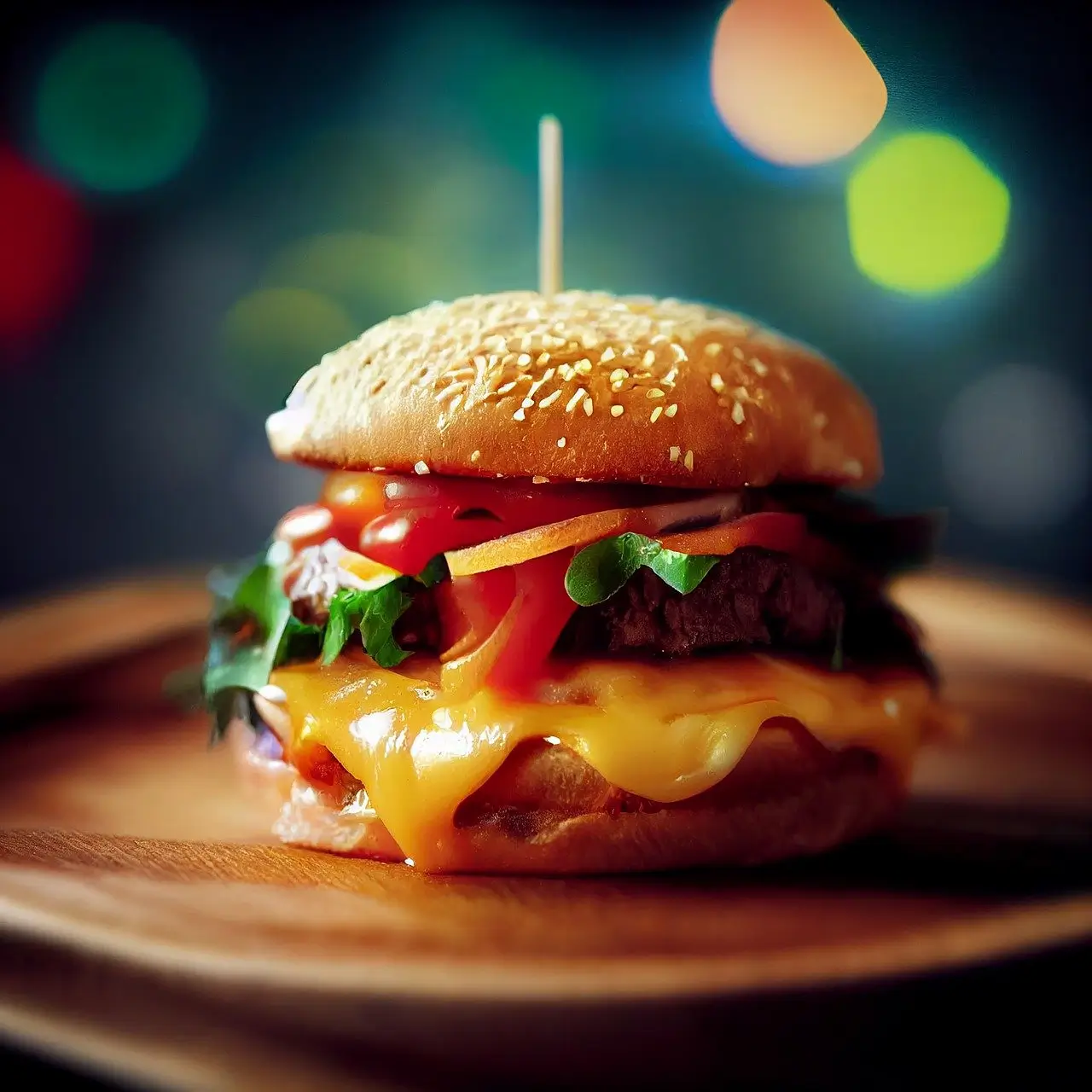
Image by Hansuan Fabregas from Pixabay
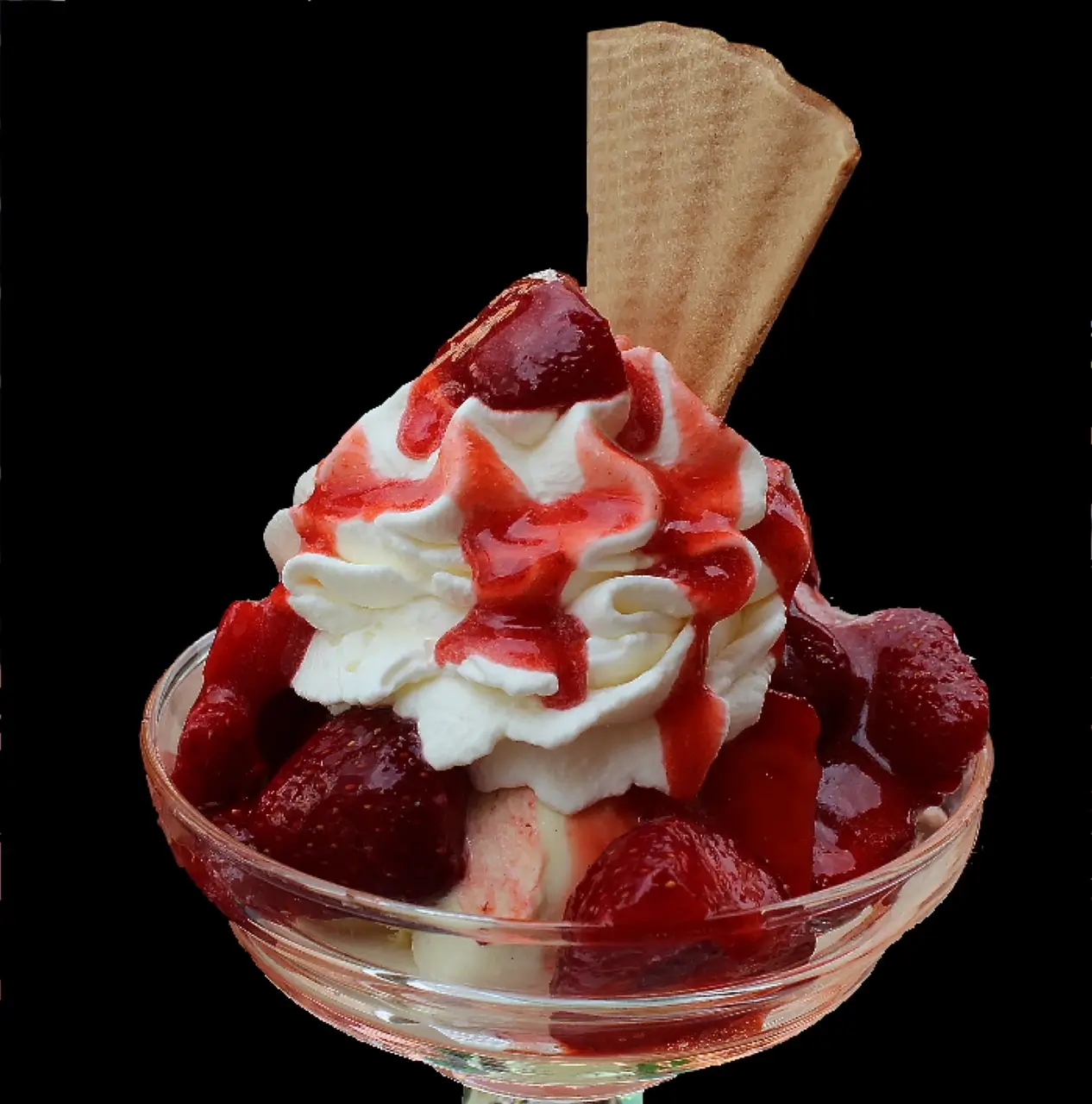
Ice cream, Yummy from Pixabay
Advertisers were the pioneers of overly staged food presentations. They showcased food products in highly aesthetic ways, borrowing from techniques used in pornography like close-ups, sensual music, and slow-motion shots. This trend still persists in advertising today.
From the 1980s and 1990s, this term described the almost erotic portrayal of food in commercials. Brands sometimes used attractive women, occasionally dressed provocatively, to promote their products, or showcased dripping chocolate or sauce to promote others. The fast-food brands are famous for adhering to the codes of Foodporn.
Thus, advertisers highlight a plethora of enticing images of food products to sell them. One can see close-ups, elaborate lighting, and saturated colors in their advertisements. As Apicius said, The first taste is always with the eyes, meaning the first glimpse of taste comes from the first glance. Advertisers seem to have understood this well. Advertisements must therefore be creatively attractive, sensual, and staged.
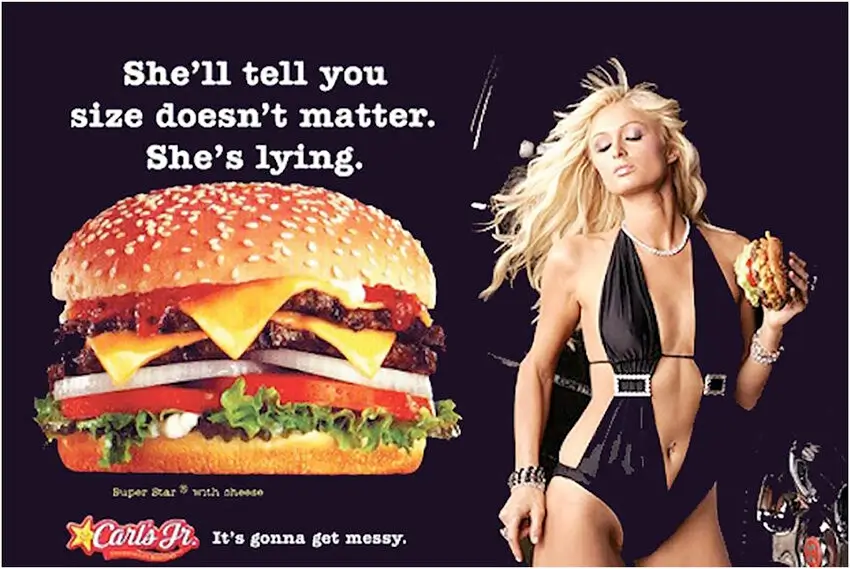
Advertisement “Carl's Jr.” © 2005, CKE Restaurants
A commercial featuring Paris Hilton washing a car in a bikini and eating a burger set a precedent for brands. The ad sparked protests and attracted so many viewers that it crashed the Carl's Jr. website in 2005.
The Surge on Social Media and in the Media
In recent years, Foodporn has evolved into a new dimension, fueled by the influence of social media. This trend has captured the attention of cooking enthusiasts worldwide. The art of staging food photos has seen significant growth, especially with the rise of the Internet. Technological advancements, such as smartphones equipped with advanced cameras, and the widespread use of social media platforms have facilitated the widespread adoption of this practice. Today, social media provides a platform for sharing activities with a much larger audience. With the convenience of mobile phones, anyone, regardless of their level of expertise, can capture photos of their dishes to share and discuss with friends. We see a plethora of individuals, including food bloggers and amateurs, snapping pictures of their meals, whether dining out or at home, and posting them on blogs or social media platforms.
The rise of social media, especially Instagram, has led to a surge in food images, making it a hub for Foodporn photos. This trend has significantly advanced the practice of food photography. On Instagram, users can give positive feedback through likes or leave comments on posted photos. This phenomenon is known as foodstagramming, where people take pictures of their meals and instantly share them on Instagram. For some, it is a true artistic challenge that involves color, lighting, and aesthetic sense to photograph an image worthy of a prestigious recipe book. The account @foodporn has 2.4M followers!
Some restaurateurs, frustrated by customers constantly photographing their dishes, have taken steps to curb this practice. It's now common to see diners snapping multiple pictures of their meals in restaurants. Some exasperated chefs have openly expressed their annoyance and fatigue with this trend. Some evoke their intellectual property rights, while others criticize the reductive aspect of this practice, which highlights the appearance of the dish over its taste. Others have gone so far as to ban customers from photographing their dishes, like the Michelin-starred chef Alexandre Gauthier. Indeed, his menu features a crossed-out camera icon.
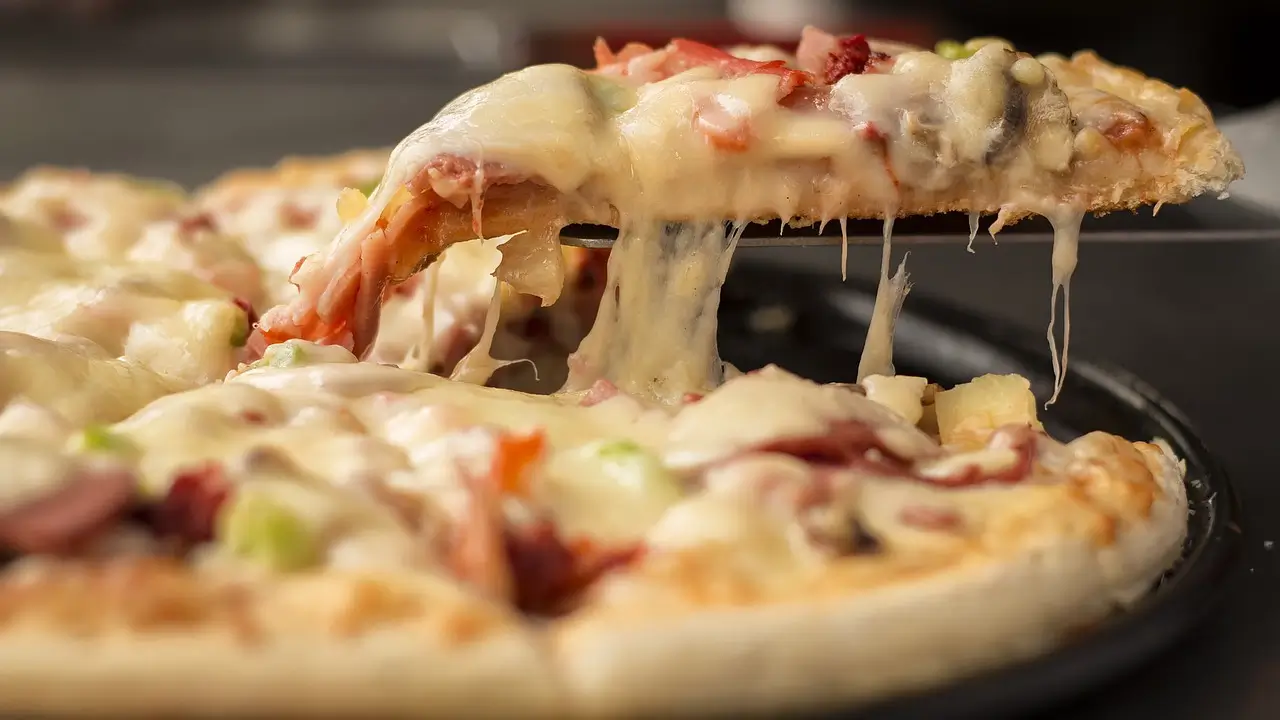
Image by marcos vega from Pixabay
There are communities of foodies – people who are enthusiastic amateurs, sometimes deeply passionate about food. They take photos of their meals and share them on social media. Highly visible in the public sphere, foodies have become an active community of gourmets on social platforms. They are often on the lookout for new culinary experiences to share with their followers.
The foodie community's photo sharing adds another layer of engagement. Beyond just posting pictures, it allows for the introduction of recipes or new dining spots. It's not just about individual food experiences; it's about creating a genuine social connection.
In recent years, numerous Foodporn channels have emerged on Facebook. Culinary videos from pages like Tasty, Tastemade, and Om Nom Nom attract millions of views. Buzzfeed, known for its social media-based entertainment news, started a cooking channel in 2015 called Tasty. It quickly gained millions of fans globally and became one of the most viewed video pages on Facebook. These videos are short, featuring simple recipes with quick editing and well-placed camera angles to make the instructions easy to follow. With its success, this channel has diversified by offering other channels like Tasty Japan, which provides more local content, or Tasty Happy Hour, dedicated to cocktails. A recent study called Cooking Trends Among Millennials: Welcome To The Digital Kitchen, published in 2016 by Google, shows that 75% of individuals aged 25 to 34 claim to be subscribed to a foodie channel.
According to Emily Fleischaker, (former editor-in-chief at BuzzFeed Food now Deputy Food Editor at The New York Times), food is an easy topic of conversation on social media, whether you know each other well or not. It's light and generally not too serious or political. Not everyone uses makeup, enjoys fitness, gets married, has children, or likes to cook. But everyone eats. Food, therefore, serves as a universal language that helps connect with friends or family, easily achieved by sharing videos. A free app called Foodie, launched in February 2016, capitalizes on this trend by making food photos look even more appetizing.
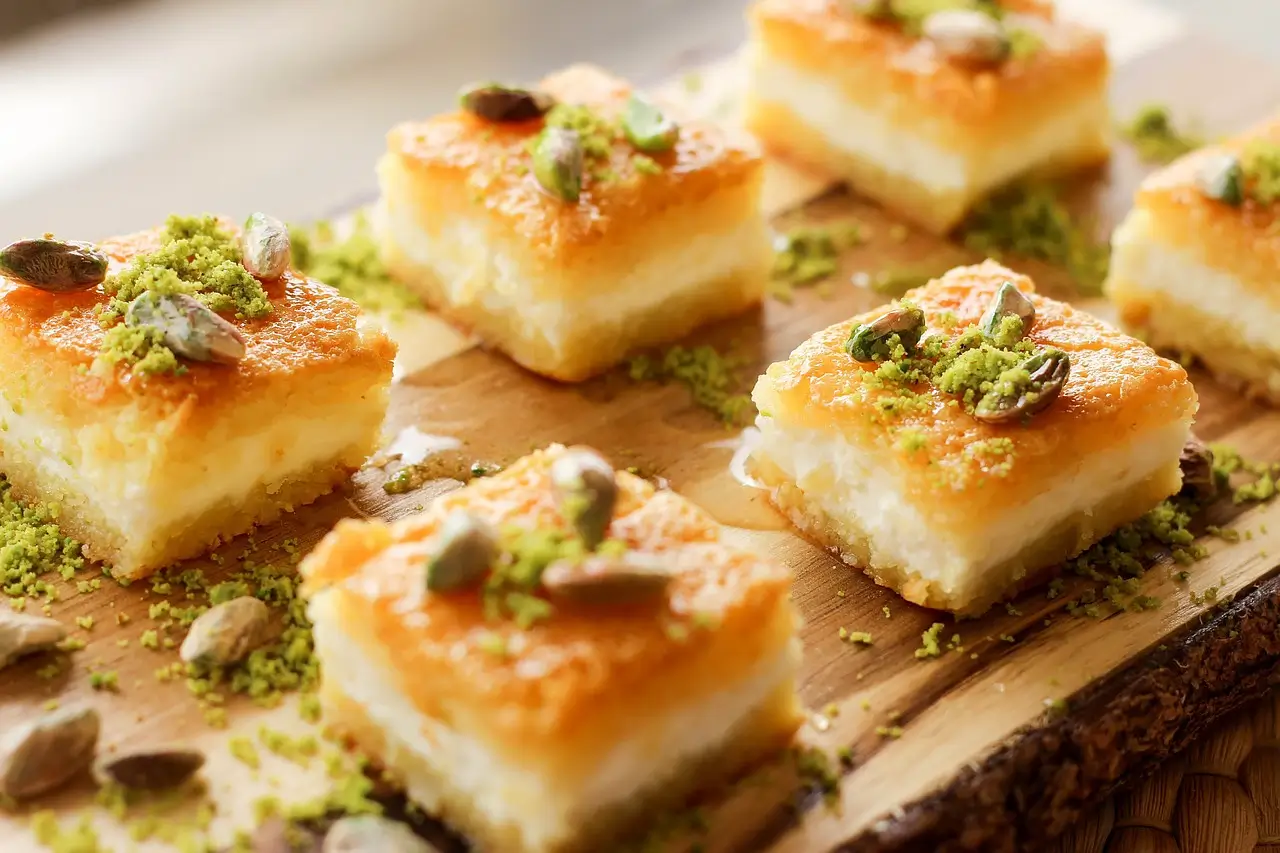
Image by Firas Hassoun from Pixabay
To whet the appetite, a dish needs to look appetizing. The visual appeal plays a crucial role in the dining experience, and restaurant owners understand this well. Foodporn has become a tool for retaining customers. With this trend, restaurateurs can showcase their creations through photos to attract new clients to their establishments.
While some view Foodporn as a threat, others see it as a fast and cost-effective way to promote their cuisine and increase their visibility among the public. Many restaurant owners are capitalizing on the Foodporn trend by using hashtags like #foodporn to gain recognition on social media. Restaurants openly admit to spending more time on making their food look, “pornographic” when posting on social media
A research paper in the Journal of Consumer Marketing reveals that snapping photos of meals before eating and posting them on social media heightens the enjoyment of the dining experience. It also improves how the food is perceived, leading to a more positive impression for the customer.
This trend isn't just limited to enthusiasts known as foodies but also impacts professional restaurateurs whose dishes gain exposure through this hashtag.
Advanced camera technology in smartphones is a boon for restaurant owners, enabling them to showcase their dishes effectively. Foodporn serves as a free advertising tool for restaurateurs to promote their offerings. For some restaurateurs, it is a means of communication and a real marketing tool.
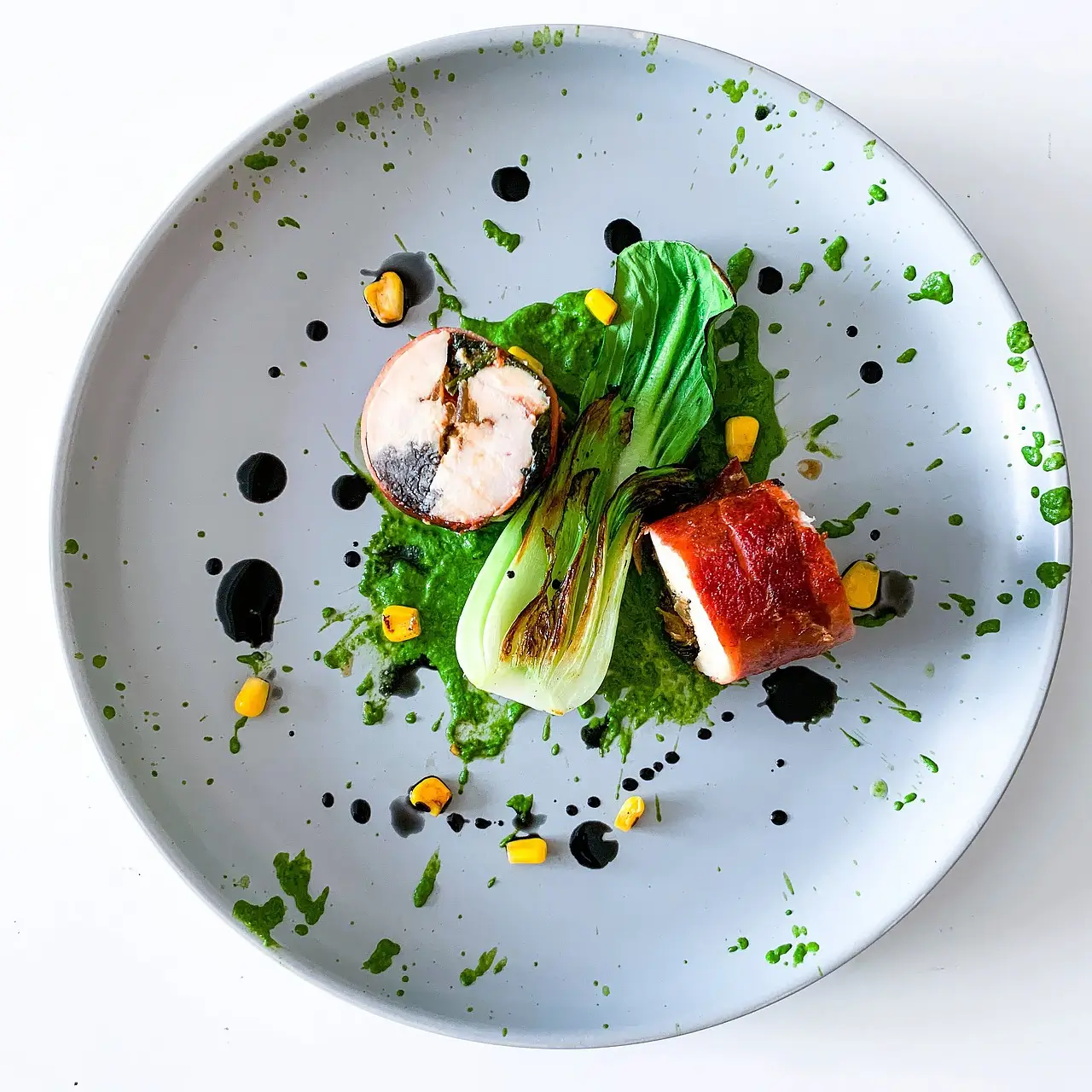
Image by Ibnasohan from Pixabay
#Foodporn has revolutionized our food cravings and desires. Depending on your perspective, this can be seen as either a positive or negative change. Whether it's a luscious, chocolate-covered treat, a gooey, cheesy indulgence, or a freshly baked, fluffy donut, food has become inherently appealing. After all, adding porn to anything tends to grab attention. Just when you thought foodporn in the restaurant scene had reached its peak, there's talk of a new trend on the horizon: #foodgasm
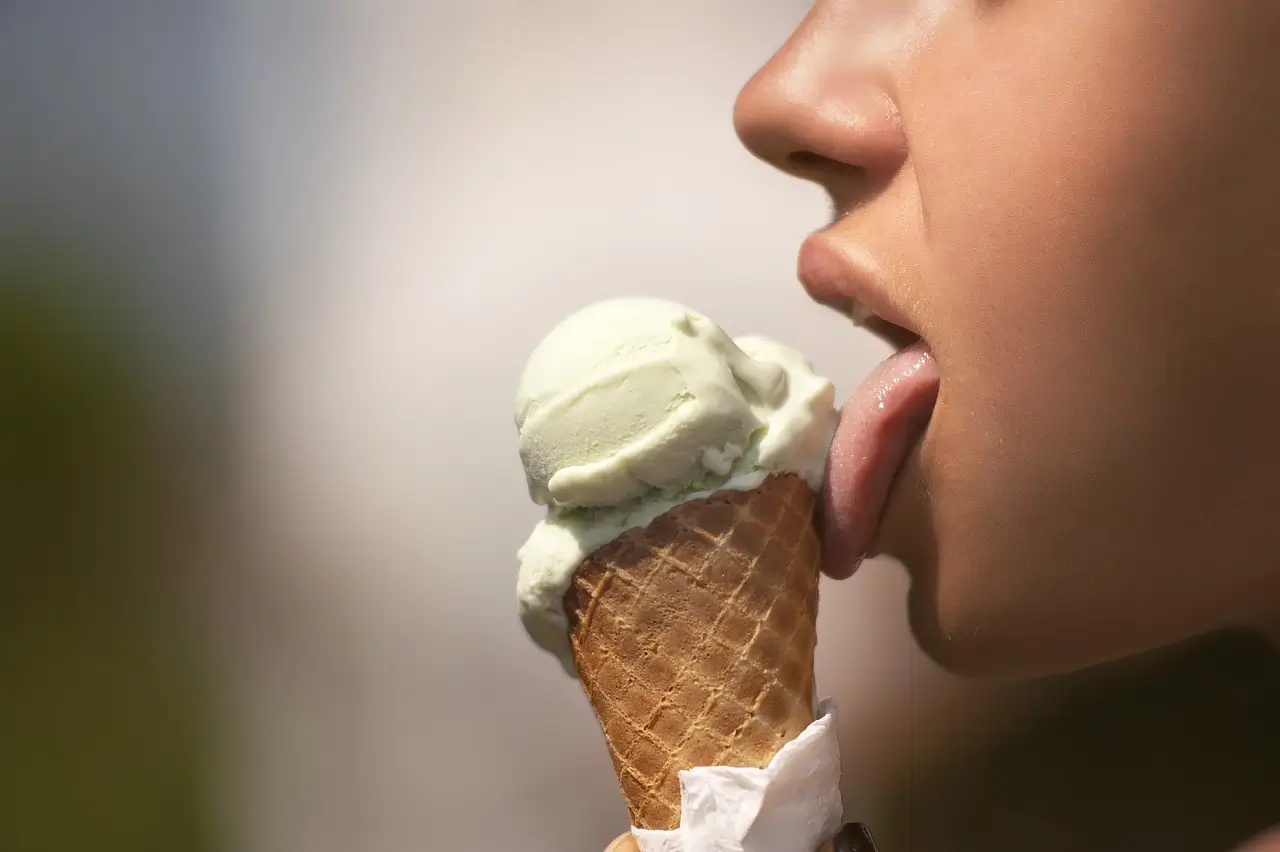
Image by StockSnap from Pixabay
